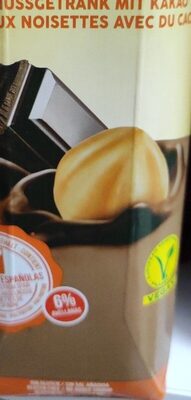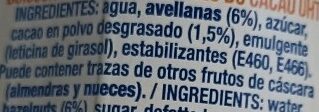Ajuda'ns a fer que la transparència alimentària sigui la norma!
Com a organització sense ànim de lucre, depenem de les vostres donacions per continuar informant els consumidors de tot el món sobre tot allò què mengen.
La revolució alimentària comença amb tu!
Bebida de avellanas con cacao - Nectina - 1 l
Bebida de avellanas con cacao - Nectina - 1 l
Aquesta pàgina del producte no està completa. Podeu ajudar a completar-la editant-la i afegint-hi més dades a partir de les fotos ja disponibles, o fent-ne més amb l'aplicació de androide o iPhone / iPad. Gràcies!
×
Codi de barres: 8412737220255 (EAN / EAN-13)
Nom comú: Bebida de avellanas con cacao UHT
Quantitat: 1 l
Empaquetament: en:multilayer-composite, Tetra Pak, Tetra Brik
Marques: Nectina
Categories: Aliments i begudes amb base vegetal, Begudes, Aliments amb base vegetal, en:Dairy substitutes, Substitutius de la llet, Fruits secs i derivats, Begudes amb base vegetal, Begudes vegetals, Beguda de fruits secs, en:Hazelnut-based drinks, es:Bebida de avellanas con cacao, es:Bebida de cacao
Etiquetes, certificacions, premis:
Vegetarià, Vegà, Unió Vegetariana Europea, Unió Vegana Vegetariana Europea

Origen del producte i / o dels seus ingredients: Avellana: España
Origen dels ingredients: Espanya, es:Tarragona
Llocs de fabricació o processament: Tarragona
Enllaç a la pàgina del producte en el lloc oficial del productor: http://www.nectina.com
Països on es va vendre: Espanya
Matching with your preferences
Salut
Ingredients
-
9 ingredients
: Agua, avellanas (6%), azúcar, cacao en polvo desgrasado (1,5%), emulgente (lecitina de girasol), estabilizantes (E460, E466)Al·lèrgens: en:NutsRastres: en:Nuts
Processament d'aliments
-
Aliments ultra processats
Elements que indiquen que el producte està al grup 4 - Aliments i begudes ultraprocessats:
- Additiu: E322 - Lecitines
- Additiu: E460 - Cel·lulosa
- Additiu: E466 - Carboximetilcellulosa sòdica
- Ingredient: Emulsionant
Els productes alimentaris es classifiquen en 4 grups segons el seu grau de processament:
- Aliments no processats o mínimament processats
- Ingredients culinaris processats
- Aliments processats
- Aliments ultra processats
La determinació del grup es fa en funció de la categoria del producte i dels ingredients que conté.
Additius
-
E322 - Lecitines
Lecithin: Lecithin -UK: , US: , from the Greek lekithos, "egg yolk"- is a generic term to designate any group of yellow-brownish fatty substances occurring in animal and plant tissues, which are amphiphilic – they attract both water and fatty substances -and so are both hydrophilic and lipophilic-, and are used for smoothing food textures, dissolving powders -emulsifying-, homogenizing liquid mixtures, and repelling sticking materials.Lecithins are mixtures of glycerophospholipids including phosphatidylcholine, phosphatidylethanolamine, phosphatidylinositol, phosphatidylserine, and phosphatidic acid.Lecithin was first isolated in 1845 by the French chemist and pharmacist Theodore Gobley. In 1850, he named the phosphatidylcholine lécithine. Gobley originally isolated lecithin from egg yolk—λέκιθος lekithos is "egg yolk" in Ancient Greek—and established the complete chemical formula of phosphatidylcholine in 1874; in between, he had demonstrated the presence of lecithin in a variety of biological matters, including venous blood, in human lungs, bile, human brain tissue, fish eggs, fish roe, and chicken and sheep brain. Lecithin can easily be extracted chemically using solvents such as hexane, ethanol, acetone, petroleum ether, benzene, etc., or extraction can be done mechanically. It is usually available from sources such as soybeans, eggs, milk, marine sources, rapeseed, cottonseed, and sunflower. It has low solubility in water, but is an excellent emulsifier. In aqueous solution, its phospholipids can form either liposomes, bilayer sheets, micelles, or lamellar structures, depending on hydration and temperature. This results in a type of surfactant that usually is classified as amphipathic. Lecithin is sold as a food additive and dietary supplement. In cooking, it is sometimes used as an emulsifier and to prevent sticking, for example in nonstick cooking spray.Origen: Wikipedia (Anglès)
-
E322i - Lecitina
Lecithin: Lecithin -UK: , US: , from the Greek lekithos, "egg yolk"- is a generic term to designate any group of yellow-brownish fatty substances occurring in animal and plant tissues, which are amphiphilic – they attract both water and fatty substances -and so are both hydrophilic and lipophilic-, and are used for smoothing food textures, dissolving powders -emulsifying-, homogenizing liquid mixtures, and repelling sticking materials.Lecithins are mixtures of glycerophospholipids including phosphatidylcholine, phosphatidylethanolamine, phosphatidylinositol, phosphatidylserine, and phosphatidic acid.Lecithin was first isolated in 1845 by the French chemist and pharmacist Theodore Gobley. In 1850, he named the phosphatidylcholine lécithine. Gobley originally isolated lecithin from egg yolk—λέκιθος lekithos is "egg yolk" in Ancient Greek—and established the complete chemical formula of phosphatidylcholine in 1874; in between, he had demonstrated the presence of lecithin in a variety of biological matters, including venous blood, in human lungs, bile, human brain tissue, fish eggs, fish roe, and chicken and sheep brain. Lecithin can easily be extracted chemically using solvents such as hexane, ethanol, acetone, petroleum ether, benzene, etc., or extraction can be done mechanically. It is usually available from sources such as soybeans, eggs, milk, marine sources, rapeseed, cottonseed, and sunflower. It has low solubility in water, but is an excellent emulsifier. In aqueous solution, its phospholipids can form either liposomes, bilayer sheets, micelles, or lamellar structures, depending on hydration and temperature. This results in a type of surfactant that usually is classified as amphipathic. Lecithin is sold as a food additive and dietary supplement. In cooking, it is sometimes used as an emulsifier and to prevent sticking, for example in nonstick cooking spray.Origen: Wikipedia (Anglès)
-
E460 - Cel·lulosa
Cellulose: Cellulose is an organic compound with the formula -C6H10O5-n, a polysaccharide consisting of a linear chain of several hundred to many thousands of β-1→4- linked D-glucose units. Cellulose is an important structural component of the primary cell wall of green plants, many forms of algae and the oomycetes. Some species of bacteria secrete it to form biofilms. Cellulose is the most abundant organic polymer on Earth. The cellulose content of cotton fiber is 90%, that of wood is 40–50%, and that of dried hemp is approximately 57%.Cellulose is mainly used to produce paperboard and paper. Smaller quantities are converted into a wide variety of derivative products such as cellophane and rayon. Conversion of cellulose from energy crops into biofuels such as cellulosic ethanol is under development as a renewable fuel source. Cellulose for industrial use is mainly obtained from wood pulp and cotton.Some animals, particularly ruminants and termites, can digest cellulose with the help of symbiotic micro-organisms that live in their guts, such as Trichonympha. In human nutrition, cellulose is a non-digestible constituent of insoluble dietary fiber, acting as a hydrophilic bulking agent for feces and potentially aiding in defecation.Origen: Wikipedia (Anglès)
-
E466 - Carboximetilcellulosa sòdica
Carboxymethyl cellulose: Carboxymethyl cellulose -CMC- or cellulose gum or tylose powder is a cellulose derivative with carboxymethyl groups --CH2-COOH- bound to some of the hydroxyl groups of the glucopyranose monomers that make up the cellulose backbone. It is often used as its sodium salt, sodium carboxymethyl cellulose.Origen: Wikipedia (Anglès)
Anàlisi dels ingredients
-
No conté oli de palma
No s'han detectat ingredients que continguin oli de palma
-
Vegà
No s'han detectat ingredients no vegans
-
Vegetarià
No s'han detectat ingredients no vegetarians
-
Detalls de l'anàlisi dels ingredients
: Agua, avellanas 6%, azúcar, cacao en polvo desgrasado 1.5%, emulgente (lecitina de girasol), estabilizantes (e460, e466)- Agua -> en:water - vegan: yes - vegetarian: yes - ciqual_food_code: 18066 - percent_min: 85.8 - percent_max: 91
- avellanas -> en:hazelnut - vegan: yes - vegetarian: yes - ciqual_food_code: 15004 - percent_min: 6 - percent: 6 - percent_max: 6
- azúcar -> en:sugar - vegan: yes - vegetarian: yes - ciqual_proxy_food_code: 31016 - percent_min: 1.5 - percent_max: 3.7
- cacao en polvo desgrasado -> en:fat-reduced-cocoa-powder - vegan: yes - vegetarian: yes - ciqual_food_code: 18100 - percent_min: 1.5 - percent: 1.5 - percent_max: 1.5
- emulgente -> en:emulsifier - percent_min: 0 - percent_max: 1.5
- lecitina de girasol -> en:sunflower-lecithin - vegan: yes - vegetarian: yes - percent_min: 0 - percent_max: 1.5
- estabilizantes -> en:stabiliser - percent_min: 0 - percent_max: 1.5
- e460 -> en:e460 - vegan: yes - vegetarian: yes - percent_min: 0 - percent_max: 1.5
- e466 -> en:e466 - vegan: yes - vegetarian: yes - percent_min: 0 - percent_max: 0.75
- Avellana: España
Avellana -> en:hazelnut
Nutrició
-
Bona qualitat nutricional
⚠ ️Atenció: la quantitat de fruita, verdura i fruits secs no s'especifica a l'etiqueta, s'ha fet una estimació a partir de la llista d'ingredients: 6Aquest producte no es considera una beguda per al càlcul de la Nutri-Score.
Punts positius: 0
- Proteïnes: 0 / 5 (valor: 1, valor arrodonit: 1)
- Fibra: 0 / 5 (valor: 0.8, valor arrodonit: 0.8)
- Fruites, verdures, fruits secs i olis de colza/nou/oliva: 0 / 5 (valor: 6, valor arrodonit: 6)
Punts negatius: 0
- Energia: 0 / 10 (valor: 270, valor arrodonit: 270)
- Sucres: 0 / 10 (valor: 3.7, valor arrodonit: 3.7)
- Greixos saturats: 0 / 10 (valor: 0.7, valor arrodonit: 0.7)
- Sodi: 0 / 10 (valor: 40, valor arrodonit: 40)
Els punts per proteïnes es compten perquè els punts negatius són inferiors a 11.
Puntuació nutricional: (0 - 0)
Nutri-Score:
-
Nivells de nutrients
-
Greix en Quantitat moderada (3.4%)
Què us cal saber- Un alt consum de greixos, especialment de greixos saturats, pot augmentar el colesterol, que augmenta el risc de patir malalties del cor.
Recomanació: Reduïu el consum de greixos i greixos saturats- Trieu productes amb menys greixos i greixos saturats.
-
Àcid gras saturat en baixa quantitat (0.7%)
Què us cal saber- Un alt consum de greixos, especialment de greixos saturats, pot augmentar el colesterol, que augmenta el risc de patir malalties del cor.
Recomanació: Reduïu el consum de greixos i greixos saturats- Trieu productes amb menys greixos i greixos saturats.
-
Sucre en Quantitat moderada (3.7%)
Què us cal saber- Un alt consum de sucre pot provocar augment de pes i càries dental. També augmenta el risc de patir diabetis tipus 2 i malalties cardiovasculars.
Recomanació: Limitau el consum de sucre i de begudes ensucrades- Les begudes ensucrades (com ara refrescos, begudes de fruites i sucs i nèctars de fruites) s'han de limitar tant com sigui possible (no més d'1 got al dia).
- Triau productes amb menor contingut de sucre i reduïu el consum de productes amb sucres afegits.
-
Sal comuna en baixa quantitat (0.1%)
Què us cal saber- Un alt consum de sal (o sodi) pot provocar un augment de la pressió arterial, que pot augmentar el risc de patir malalties del cor i ictus.
- Moltes persones que tenen hipertensió no ho saben, ja que sovint no en tenen símptomes.
- La majoria de la gent consumeix massa sal (de 9 a 12 grams de mitjana al dia), al voltant del doble del nivell màxim d'ingesta recomanat.
Recomanació: Limitau la ingesta de sal i d'aliments rics en sal- Reduïu la sal que emprau quan cuinau, i no afegiu sal a taula.
- Limiteu el consum d'aperitius salats i trieu productes amb menor contingut de sal.
-
-
Informació nutricional
Informació nutricional Com es ven
per 100 g/100 mlCom es ven
per porció (200 ml)Comparat amb: en:Hazelnut-based drinks Energia 270 kj
(65 kcal)540 kj
(130 kcal)+48% Greix 3,4 g 6,8 g +62% Àcid gras saturat 0,7 g 1,4 g +204% Àcid gras monoinsaturat 2,4 g 4,8 g Àcid gras poliinsaturat 0,3 g 0,6 g Hidrats de carboni 7,2 g 14,4 g +44% Sucre 3,7 g 7,4 g +6% Fiber 0,8 g 1,6 g Proteïna 1 g 2 g +89% Sal comuna 0,1 g 0,2 g -7% Fruits‚ vegetables‚ nuts and rapeseed‚ walnut and olive oils (estimate from ingredients list analysis) 6 % 6 %
Entorn
-
Eco-puntuació A - Impacte ambiental molt baix
El Eco-Score és una puntuació experimental que resumeix els impactes ambientals dels productes alimentaris.→ L'Eco-Score es va desenvolupar inicialment a França i s'està ampliant per a altres països europeus. La fórmula Eco-Score està subjecta a canvis, ja que es millora periòdicament per fer-la més precisa i més adequada per a cada país.Anàlisi del cicle de vida
-
Impacte mitjà dels productes de la mateixa categoria: B (Score: 79/100)
Categoria: Almond drink not sweet, not fortified, prepacked
Categoria: Almond drink not sweet, not fortified, prepacked
- Puntuació ambiental PEF ( petjada ambiental de l'aliment ): 0.06 (com més baixa sigui la puntuació, menor serà l'impacte)
- incloent l'impacte sobre el canvi climàtic: 0.37 kg CO₂ eq/kg del producte
Etapa Impacte Agricultura
37.0 %Processament
24.3 %Empaquetament
16.2 %Transport
15.6 %Distribució
6.9 %Consum
0.0 %
Bonificacions i punts negatius
-
Orígens dels ingredients amb baix impacte
Bonificació: +18
Política ambiental: +3
Transport: +15
Origen del producte i / o dels seus ingredients % d'ingredients Impacte Espanya 100 %Baix
-
Embalatge de baix impacte
Punts negatius: -4
Forma Material Reciclatge Impacte 1 Brick Tetra Brik ecoponto-amarelo Mitjà
Eco-Score per a aquest producte
-
Impacte per a aquest producte: A (Score: 93/100)
Producte: Bebida de avellanas con cacao - Nectina - 1 l
Puntuació de l'anàlisi del cicle de vida: 79
Suma de bonificacions i punts negatius: +14
Puntuació final: 93/100
-
Petjada de carboni
-
Equivalent a conduir 0.2 km en un cotxe de gasolina
37 g de CO² per cada 100 g de producte
La xifra d'emissions de carboni prové de la base de dades Agribalyse d'ADEME, per a la categoria: Almond drink not sweet, not fortified, prepacked (Font: Base de dades ADEME Agribalyse)
Etapa Impacte Agricultura
19.2 %Processament
18.5 %Empaquetament
26.9 %Transport
31.6 %Distribució
3.9 %Consum
0.0 %
Empaquetament
-
Embalatge de baix impacte
-
Peces d'embalatge
1 x Brick 1 L (Tetra Brik: 0.042 g)
-
Materials d'embalatge
Material % Pes de l'embalatge Pes de l'embalatge per 100 g de producte
-
Transport
-
Orígens dels ingredients
Orígens dels ingredients amb baix impacte
Origen del producte i / o dels seus ingredients % d'ingredients Impacte Espanya 100 %Baix
Report a problem
-
Incomplete or incorrect information?
Category, labels, ingredients, allergens, nutritional information, photos etc.
If the information does not match the information on the packaging, please complete or correct it. Open Food Facts is a collaborative database, and every contribution is useful for all.
Fonts de dades
Producte afegit per elcoco
Última modificació de la pàgina del producte per nectinaoriginal.
La pàgina del producte, també editada per duhowpi, itsjustruby, kiliweb, spotter, yuka.sY2b0xO6T85zoF3NwEKvlkxXcvnY_2LGaBnUtFah6NGjALPjbf55v5PTKKs.










